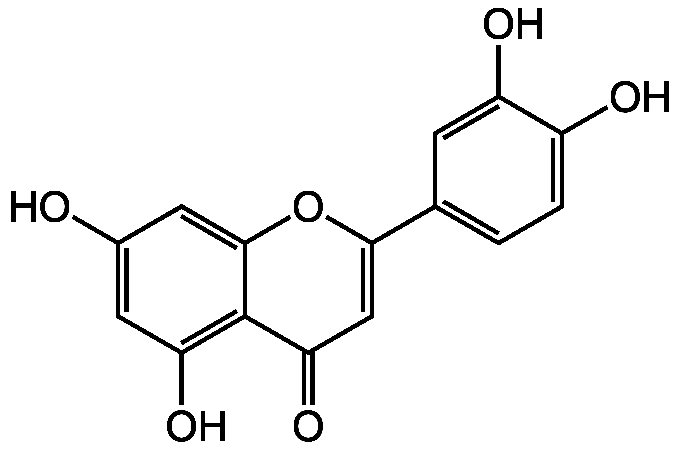Luteolin
Product Code: AG-CN2-0098
Product Group: Natural Products and Extracts
Supplier: AdipoGen Life Sciences
| Code | Size | Price |
|---|
| AG-CN2-0098-M005 | 5 mg | £22.00 |
Quantity:
| AG-CN2-0098-M025 | 25 mg | £46.00 |
Quantity:
Prices exclude any Taxes / VAT
Overview
Regulatory Status: RUO
Shipping:
Ambient
Storage:
+4°C
Images
Further Information
Alternate Names/Synonyms:
3',4',5,7-Tetrahydroxyflavone; Luteolol; BRN 0292084; C.I. Natural Yellow 2; Digitoflavone; Flacitran; Flavopurpol; Daphneflavonol; Argemexitin
Appearance:
Yellow solid.
CAS:
491-70-3
EClass:
32160000
Form (Short):
liquid
GHS Symbol:
GHS07
Hazards:
H315, H319, H335
InChi:
InChI=1S/C15H10O6/c16-8-4-11(19)15-12(20)6-13(21-14(15)5-8)7-1-2-9(17)10(18)3-7/h1-6,16-19H
InChiKey:
IQPNAANSBPBGFQ-UHFFFAOYSA-N
Long Description:
Chemical. CAS: 491-70-3. Formula: C15H10O6. MW: 286.2. Synthetic. Anticancer and antimetastatic. alpha-Glucosidase inhibitor. Topoisomerase I Inhibitor. Apoptosis inducer. Anti-inflammatory. 15-Lipoxygenase (15-LOX) inhibitor. IL-6 production inhibitor. Fatty acid synthase (FAS) inhibitor. Antioxidant. Free radical scavenger. Antiadipogenic. PPAR-gamma inhibitor. Neuroprotective. Monoamine transporter activator. Inhibitor of phosphodiesterases 1-5 (PDE1-5). PKC(epsilon) and Src kinase
MDL:
MFCD00017309
Molecular Formula:
C15H10O6
Molecular Weight:
286.2
Package Type:
Vial
Precautions:
P261, P280, P302, P352, P312
Product Description:
Anticancer and antimetastatic agent that induces apoptosis and modulates autophagy. Shown to inhibits kinase signalling, including PKC(epsilon) and Src kinase, HDAC, Phosphatidylinositol 3-kinase (PI3K) / Akt and p90 ribosomal S6 kinase (RSK1/RSK2). Topoisomerase I Inhibitor. Anti-inflammatory agent that inhibits 15-Lipoxygenase (15-LOX) and IL-6 production. Antioxidant. Free radical scavenger. Antiadipogenic agent, that inhibits PPAR-gamma, fatty acid synthase (FAS) and alpha-Glucosidase. Neuroprotective. Monoamine transporter activator and inhibitor of phosphodiesterases 1-5 (PDE1-5). Shown to selectively inhibits chymotrypsin-like and trypsin-like proteasome catalytic activity.
Purity:
>98% (HPLC)
Signal Word:
Warning
SMILES:
OC1=CC(O)=C2C(=O)C=C(OC2=C1)C1=CC=C(O)C(O)=C1
Solubility Chemicals:
Soluble in DMSO, DMF, methanol or ethanol. Slightly soluble in water.
Source / Host:
Synthetic.
Transportation:
Non-hazardous
UNSPSC Category:
Natural Products/Extracts
UNSPSC Number:
12352200
Use & Stability:
Stable for at least 2 years after receipt when stored at -20°C.
References
Effects of luteolin and quercetin, inhibitors of tyrosine kinase, on cell growth and metastasis-associated properties in A431 cells overexpressing epidermal growth factor receptor: Y.T. Huang, et al.; Br. J. Pharmacol. 128, 999 (1999) | Inhibition of alpha-glucosidase and amylase by luteolin, a flavonoid: J.S. Kim, et al.; Biosci. Biotechnol. Biochem. 64, 2458 (2000) | Luteolin, an emerging anti-cancer flavonoid, poisons eukaryotic DNA topoisomerase I: A.R. Chowdhury, et al.; Biochem. J. 366, 653 (2002) | Inhibition of matrix-proteases by polyphenols: Chemical insights for anti-inflammatory and anti-invasion drug design: L. Sartor, et al.; Biochem. Pharmacol. 64, 229 (2002) | Luteolin inhibits the nuclear factor-kappa B transcriptional activity in Rat-1 fibroblasts: S.H. Kim, et al.; Biochem. Pharmacol. 66, 955 (2003) | Inhibition of 15-lipoxygenases by flavonoids: Structure-activity relations and mode of action: C.D. Sadik, et al.; Biochem. Pharmacol. 65, 773 (2003) | Induction of apoptosis by luteolin through cleavage of Bcl-2 family in human leukemia HL-60 cells: A.C. Cheng, et al.; Eur. J. Pharmacol. 509, 1 (2005) | Luteolin inhibits insulin-like growth factor 1 receptor signaling in prostate cancer cells: J. Fang, et al.; Carcinogenesis 28, 713 (2007) | Luteolin reduces IL-6 production in microglia by inhibiting JNK phosphorylation and activation of AP-1: S. Jang, et al.; PNAS 105, 7534 (2008) | Inhibition of fatty acid synthase by luteolin post-transcriptionally down-regulates c-Met expression independent of proteosomal/lysosomal degradation: D.T. Coleman, et al.; Mol. Cancer Ther. 8, 214 (2009) | Physicochemical properties and antioxidant activities of luteolin-phospholipid complex: K. Xu, et al.; Molecules 14, 3486 (2009) | Luteolin inhibits adipogenic differentiation by regulating PPARgamma activation: H.S. Park, et al.; Biofactors 35, 373 (2009) | Functional activation of monoamine transporters by luteolin and apigenin isolated from the fruit of Perilla frutescens: G. Zhao, et al.; Neurochem. Int. 56, 168 (2010) | Apigenin, Chrysin, and Luteolin Selectively Inhibit Chymotrypsin-Like and Trypsin-Like Proteasome Catalytic Activities in Tumor Cells: Y.-X. Wu & X. Fang; Planta Med. 76, 128 (2010) | Luteolin, a non-selective competitive inhibitor of phosphodiesterases 1-5, displaced [3H]-rolipram from high-affinity rolipram binding sites and reversed xylazine/ketamine-induced anesthesia: M.C. Yu, et al.; Pulmon. Gastrointest. Urogen. Pharmacol. 627, 269 (2010) | Luteolin inhibits protein kinase C(epsilon) and c-Src activities and UVB-induced skin cancer: S. Byun, et al.; Cancer Res. 70, 2415 (2010) | Inhibition of cell survival, invasion, tumor growth and histone deacetylase activity by the dietary flavonoid luteolin in human epithelioid cancer cells: S. Attoub, et al.; Eur. J. Pharmacol. 651, 18 (2011) | Autophagy inhibitor chloroquine enhanced the cell death inducing effect of the flavonoid luteolin in metastatic squamous cell carcinoma cells: L. Verschooten, et al.; PLoS One 7, e48264 | Raf and PI3K are the molecular targets for the anti-metastatic effect of Luteolin: H.Y. Kim, et al.; Phytother. Res. 27, 1481 (2013) | Luteolin is a novel p90 ribosomal S6 kinase (RSK) inhibitor that suppresses Notch4 signaling by blocking the activation of Y-box binding protein-1 (YB-1): K.M. Reipas, et al.; Oncotarget 4, 329 (2013)
Related Products
| Product Name | Product Code | Supplier | Shikonin | AG-CN2-0487 | AdipoGen Life Sciences | Summary Details | |||||||||||||||||||||||||||||||||||||||||||||||||||||||||||||||||||||||||||||||||||||||||||||
|---|---|---|---|---|---|---|---|---|---|---|---|---|---|---|---|---|---|---|---|---|---|---|---|---|---|---|---|---|---|---|---|---|---|---|---|---|---|---|---|---|---|---|---|---|---|---|---|---|---|---|---|---|---|---|---|---|---|---|---|---|---|---|---|---|---|---|---|---|---|---|---|---|---|---|---|---|---|---|---|---|---|---|---|---|---|---|---|---|---|---|---|---|---|---|---|---|---|---|---|



